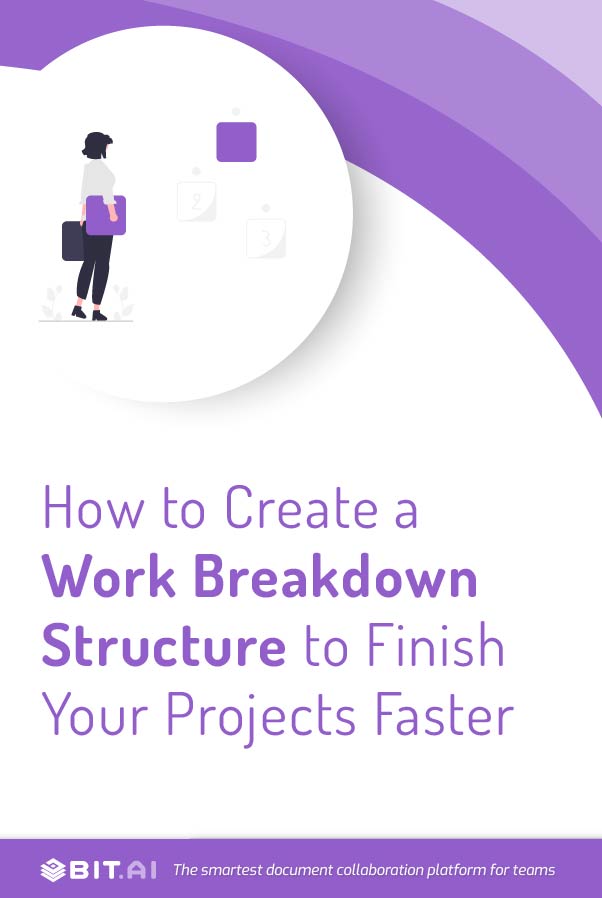A project is a complex endeavor, and we all know that. There are just so many complex tasks and deliverables during the whole project lifecycle, and it can get a little overwhelming.
In fact, according to a survey, 80% of businesses spend (or waste) at least half of their time in reworking their projects. However, it doesn’t have to be that way.
If you create a hierarchical breakdown of all the work that is required to complete your project, you can manage all the challenging projects smoothly and more efficiently.
This hierarchical breakdown is known as the ‘work breakdown structure‘, and it provides a solid foundation for your project. So, without further ado, let’s go through all the aspects of a work breakdown structure!
What is a Work Breakdown Structure? (Definition)
A work breakdown structure (WBS) is a deliverable-oriented hierarchical diagram that breaks down all the components of a project into smaller, more manageable sections.

Basically, the WBS defines the ‘what’ of the project – what needs to be done in order to meet the desired goals, what the total costs would be, and what resources are required.
Since a work breakdown structure is a hierarchical diagram, every level has a designed degree of importance. The core levels of a WBS include:
- The Top Level: This is the final product/deliverable that a team wants to achieve. Simply put, this is the end goal of the project. You might even state it as the title of the project!
- Controls Account: This comes right below the top level, and it contains all the major tasks and deliverables. It might also include the larger aspects of the project, such as pieces of equipment.
- Work Packages: Placed beneath the ‘control account’, this stage typically includes the tasks that you need to complete to progress towards the controls account.
- Activities: These are the smallest tasks of the project, and that’s why this stage is placed at the end of the WBS. Nonetheless, these are the first tasks that a team would work on when the project starts.
Three Types of Work Breakdown Structure
1. Phase-Based Structure
The success of a project depends on how well you handle every phase of the project. If you make an error in one phase, it could hamper the progress of another! Ultimately, the entire project might get disturbed. Through a phase-based structure, you describe all the project activities clearly, leading to a smoother execution!
2. Deliverable-Based Structures
In a deliverable-based structure, you can divide and organize your project tasks according to the deliverables that you’ve agreed upon. After all, if you fail to provide the deliverables that you promised to your client, they are unlikely to trust you the next time. This would put a brake on the growth of your business.
3. Responsibility-Based Structure
With a responsibility-based structure, you define all the project activities according to the responsibility each project executive has. When everyone has a clear idea about who needs to work on which tasks and what they need to achieve in the stipulated time, the chances of the project being successful increase dramatically.
Read more: Project Kickoff: What is it & How to Create it?
6 Reasons Why You Should Create a Work Breakdown Structure
1. The Foundation of a Project
The work breakdown structure gives an overview of a project and its deliverables, and this is why it becomes the foundation for the planning stage. Whether it is cost estimation, resource estimation, time estimation, or schedule planning – you can refer to the WBS for everything.
2. Makes it Easier to Estimate Staff, Time & Cost

Making estimations about the staff requirements, cost, and time for the entire project can be a bit difficult. There is a higher possibility of deviations in the actual results! However, if you divide the entire project into smaller parts, you can make estimations easily and more accurately.
3. No More Slipping Through The Cracks
As a WBS shows the project work and deliverables that need to be completed, it guides your entire team on what needs to be done and how it needs to be done. This way, the team is able to focus on the things that actually matter to the project, and all the unnecessary work is eliminated.
4. Provides a Deeper Understanding of Roles
The WBS helps the project team understand the impact of their work on the project, and how their activities or deliverables will help in completing the project scope. In simple words, the WBS gives the team members a more profound understanding of where their pieces fit into the overall project plan.
5. Helps Prevent Changes
Changes in a project usually happen when the project scope isn’t clear. However, WBS shows the breakdown of the project scope in a much clearer way, which helps in preventing changes. Even if there are a few changes that you need to make as the project evolves, having a WBS will make the transition easier.
6. Facilitates Communication & Cooperation
A work breakdown structure shows who is responsible for which task, making it easier for everyone involved in the project to cooperate with each other in order to complete the project activities. The results? Better communication, fewer conflicts, and more chances of the project being successful.
Read more: 12 Work Management Software and Tools in 2022
How to Create a Work Breakdown Structure? (Step-By-Step)
Step 1: List Every Major Deliverable
Your major deliverables are the final products that you need to complete the project successfully. These deliverables should have already been specified in your project scope!
For example, the major deliverables of a targeted inbound marketing campaign might be emails, social media, ebooks, newsletters, blogs, downloadable collateral, and more.
If there’s any ambiguity about the project deliverables, make sure that you clear them up before diving into the work breakdown structure. This will prevent a lot of conflicts down the road.
Step 2: Break Each Deliverable Into Smaller Work Components
Let’s understand this step with an example. Suppose your deliverable is ‘social media’ You could further break it into different work components, such as Twitter, Instagram, Facebook & Linkedin.
If necessary, you can break down these work components further. For example, the work component ‘Instagram’ can have copywriting, video editing, and graphic designing as its sub-components.
There is no set requirement or limit to how many work components you can have. It completely depends on the size and scope of your project and the deliverables.
Step 3: Split Each Work Component Into Work Packages
This is the final and most detailed level in your work breakdown structure. It is basically a list of individual tasks that can be completed by one person.
Consider each work package as a small project that requires its own schedule, budget, resources, and milestones. Most importantly, make sure that each work page is unique and not repetitive.
For example, if the deliverable is ‘social media’, the work component is ‘Facebook’, and the sub-component is ‘copywriting’, then work packages could be: 2 content posts, 3 user-generated posts, and 4 sponsored posts.
Step 4: Identify The Dependencies
Once you have laid out each and every task, you need to identify the tasks that depend on other tasks in order to get completed. For example, you can’t publish the blogs unless the editor finalizes them first, right?
Once you know the order in which the tasks must be finished, you will be able to create a solid schedule, manage time more effectively and predict the roadblocks.
Step 5: Time to Prioritize and Assign
This is the last step in creating a work breakdown structure. In this step, you are supposed to organize all the tasks in order of priority, using the list that you created in the above step.
Once your WBS is in an order that makes sense, start assigning work packages to the team members. Next, create a schedule using the work packages and the major deliverables that you listed out earlier.
To maintain organization and transparency, you can include the name of the department that will be responsible for each task, the start date and deadlines, and the estimated cost of the project/work components.
Four Tips For Creating a Solid Work Breakdown Structure
1. Use Nouns, Not Verbs
The core purpose of a work breakdown structure is to describe the deliverables and not the actions that are required to produce these deliverables.
By simply stating the desired outcome of each stage using nouns, you can increase the clarity and the structure of your WBS. When it comes to WBS, what matters is the ‘what’ of the work, and now the ‘how’.
2. Ask For Feedback
When you’re developing your WBS or after you’ve completed it, it’s extremely crucial to ask for feedback! You can ask the project executives, project manager, or your team members to review it and give suggestions.

They might be able to identify missing tasks or deliverables, or they might even suggest a few ways to make the WBS or the process more efficient. As they say, two heads are better than one!
Read more: Project Outline: What is it & How to Create it for Your Business?
3. Follow the 100% Rule
A work breakdown structure needs to be thorough and exhaustive. What we are trying to say is, do not leave any deliverable in the WBS and simply follow the 100% rule.
The 100% rule of WBS states that every level should contain all the deliverables, and anything beyond that should be discarded. This helps you spot gaps, redundancies, and ensures that nothing is left behind.
4. Keep All Elements Mutually Exclusive
Besides the 100% rule, another important rule of a WBS is mutual exclusivity. Make sure that every element of your WBS is independent, and you don’t need to rely on one element to complete the other.
In case two elements are dependent on each other, it’s better to combine those two elements together into a single work package, and take the entire work package a level above.
Wrapping Up
Project goals are large, and the process of achieving those goals? That’s even more complex. Using a work breakdown structure, you can decompose those large, major components of a project into smaller tasks.
The principles that you’ve learned in this blog won’t just help you in project management, but also for any complex activity that you undertake in the future.
Hey! We know that there’s a lot of new information to digest here. If you’ve got any questions, we’re here for you! Let us know by tweeting us @bit_docs. Cheers!
Further reads:
11 Agile Project Management Tools You Should Use in 2022
9 Project Documents You Must Create For Your Project!
Best Roadmap Software You Need to Try (Free & Paid)
12 Awesome Tips To Help You Grow Your Business!



